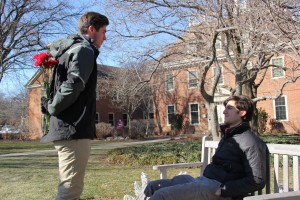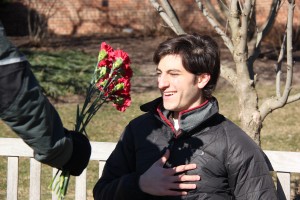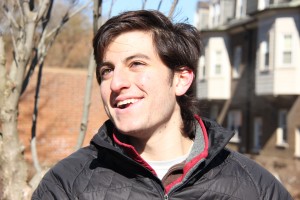The first thing that stood out to me when I started watching Cameraperson was the power of the natural sounds in the documentary. The birds chirping, the sounds of Kirsten navigating the camera, her pacing breath, her footsteps, and just how the audience can tell that there is a person behind the camera is so important. During Kirsten’s talk, she confided that she didn’t have a good ear at the beginning of her career. Sounds would just run past her ears. But as she started gaining more experience, she realized the essence of sound and how it adds life to the hundreds of images that are being displayed onscreen. I also respected how we could hear her comments and reactions to certain stories during Cameraperson. The shot I recall clearly is when the boy from Kabul, Pakistan talks about how he lost his brother and Kirsten’s voice after saying that she couldn’t hold her tears. We can tell how compassionate and affected she is through the breaking of her voice in this part.Sounds do tell a story of its own. Similar to Sergio Leone’s Once Upon A Time In The West, we hear the intensity of the drops of water falling from the broken ceiling and the irritating fly. The sounds in Leone’s film are extremely important for the film as a whole. This also reminded me of Nolan’s powerful sound effects in Dunkirk. The loud sounds of war carry the entire film, leaving scarring vibrations in your head after you leave the cinema. The essence of sound is how realistic it makes a video. As a documentarian and a film scholar, I’m trying to work on being more observant towards sound. Kirsten did also mention that she doesn’t take charge of recording the sound but she advocates the sound recording role to another professional. She believes that there are specialized people for every part in the film industry.
Author Archives: Shreya Nebhwani
Weiner
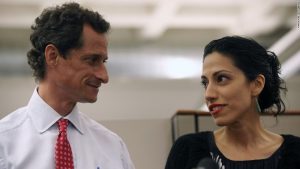
I’ve been meaning to blog about a documentary called Weiner(2016) directed by Josh Kriegman and Elyse Steinberg. After I heard Kirsten’s story and takeaway from the documentary, I was motivated to write about it. The two directors of Weiner were just there to film Anthony Weiner’s comeback campaign. For those of you who don’t know, because I didn’t until watching this, Anthony Weiner is an American former congressman who represented New York and was forced to resign after pleading guilty for his sex scandal. Back to the two documentarians who were just flies on the wall during Weiner’s campaign. There was a lot of excitement and we could see all the Democrats of the city support Weiner. As an audience, we are also introduced to Huma Abedin, Hillary Clinton’s right hand and also Weiner’s unbelievably intelligent wife. We notice how he uses his wife as a middleman for all her contacts since he needs funding during the campaign. We watch her quietly help him and stand by his side. BOOM. Sex scandal. Nude pictures that are sent from Weiner’s phone to a random woman are leaked in the media. Everyone is disgusted and there is tension all over. He keeps fighting back and asking for an apology, insisting that we are all human and make naive mistakes. Huma still stays with him and his campaign is relaunched.
Throughout the documentary, the story goes deeper and deeper. From being the lead in the election, Weiner becomes a toxic name in New York City. His personal life is an open journal for everyone, especially after the scandal surfaced. We gradually start noticing how silenced Huma is and how she is this one character who is coping and suffering the most from her husband’s actions. She is portrayed and probably was in an emotionally imprisoning relationship. The documentarians are shredding his story as the topic gets more complex. Who would’ve ever known that all this would happen going into this project? Kirsten mentioned that one of the documentarians was his Chief in staff. Professor Sikand immediately responded that she’d never be able to betray or portray her subject in such a way after they have given her permission to be a fly in the wall during such a critical point in their lives. Kirsten said that when you’re filming a documentary, you can initially be looking for x, but then you arrive at Z. She relates it to her and Laura Poitras’s experience with Julian Assange during the filming of Risk(2016). Relating to Weiner, the documentarians started off with the campaign, which lead to the reveal of the sex scandal, which transformed the story. Towards the end, the focus completely shifts towards how much Huma was suffering.
Kirsten’s takeaway was that the people directing need to have a certain persona to make the film they have. She mentioned that one of the directors, Josh Kriegman’s dad was in a cult with all of his sons. Josh was one of the sons who wasn’t part of this cult. He didn’t believe and see what they did. He turned against them. I don’t know more specifics to this story but the point is that the director also brings an attitude to the table. After watching Weiner, you can tell that the documentarians were relentless. I’m not one who is randomly interested in politics or congressmen, but this documentary is definitely worth a watch!
Link to trailer : https://youtu.be/LCoI3DdstZw
Fail To See
I still find it fascinating on how the documentarian of the ONE documentary I chose to watch this summer is coming to Lafayette. Is this a coincidence? I don’t know but I think I’ll be in shock until I hear from Kirsten Johnson tomorrow. After reading her director’s statement, what mostly stood out to me was , ” I fail to see or follow stories the director I work for hope I will follow.” This statement is honest and shows how KJ has her own opinion and thoughts. By writing this statement, she also shows how she’s entitled to perceiving situations and stories differently. She won’t completely agree with the director she’s working for because something that does make sense or seem right to the director might not align with KJ’s thoughts. KJ seems to be aware that there will discussions and decisions to be made when thoughts don’t align. From her one sentence, I can tell that she is in terms with her opinions and isn’t afraid to express these differences to her peers.
Another honest statement is, “I ask for trust, cooperation, and permission without knowing where the filming experience will lead the subject.” In other words, she tells us how that maybe while filming she might not have a fully established idea of the direction the piece will go in. But in post-production, there might be a story that will be formed.
I’m excited to watch Cameraperson for the second time tomorrow. I’m curious to see how I’ll feel towards it after this second round.
Choices
I’m very excited to get started on our documentary projects. One of the many which sounds appealing to me is Center City Thrift. Recently, there’s been this growing popularity of thrift stores. There have been a higher standard of goods that are being donated to thrift stores. But, since the past three years of being in the US, I’ve been surrounded by this thrift store hype. My friends make it a whole 2 hour event of going to the thrift store. For friends, going to the thrift store is a hobby, a major part of their style and identity. Whereas, I’ve overheard conversations between my friends and parents about Goodwill, a longstanding non profit chain with second hand clothing, furniture, jewelry, etc. Other than it being fun to rummage through tons of articles of clothes and jewelry before you find one of value, it’s fun to see how diverse the groups of people are who walk into these stores. When Ayanna mentioned that funds were being set aside to provide communal wi-fi at a thrift store in Allentown, I jumped at the thought. There are plenty of people from various socio-economical backgrounds who must be valuing this in store wi-fi and I think there voices should be heard. My first question would be to the thrift store owner: what made you think of contributing wi-fi at this store? do you believe it’s any good or serving the community in a better way?
Two other topics of interest are Borders of Belonging and The Loss We Can Gain. With regards to B.o.B, I’m aware of the large Hispanic and Latinx community here in Easton. There are several restaurants in the area that are doing really well and I’m curious to know about how these owners feel here in Easton. Has the political environment threatened them in this little town in PA? The Loss We Can Gain is essential to the community as well. Food is taken for granted and unnecessarily wasted when it could go elsewhere for a better cause. I can’t wait to see where these projects go!
Carry that backpack everywhere
“Sometimes an opportunity comes along that precludes extensive planning.” – Bernard
This weekend I was visiting my friend and her brother at the city. It was my first time meeting her brother who was actually also visiting her for the weekend from California. As we walked past a tunnel in central park, we all noticed a violinist playing a beautiful tune in the shadow of the tunnel. I noticed my friend’s brother zipping open his backpack and pulling out his DSLR. I said to myself, “okay I guess he does work in production, so that’s normal.” Later on the subway, my friend asks her brother for a band-aid and some sanitizer. Squeezed amongst so many people, he easily pulled out both the things she asked for. She laughs as I was standing there in shock. I was impressed by how prepared he was. I thought this was the case only during this weekend since he was visiting but it is in fact not! My friend mentioned that her brother carries this backpack everywhere he goes because sometimes you might run into something interesting or important and being prepared is essential. I don’t carry a camera around (phone) everywhere I go but I admired his will and passion to always being prepared. After hearing this, I thought he was a true documentarian and a very good example for me.
Through The Frame
When looking through the frame, the first thing I realized was that with the human eye, I could not focus on everything through the frame at once, especially with objects both close and far. I noticed that people do not see in an instant like a photograph, but instead need a small amount of time to focus on different areas within the frame.
The lighting would vary as I would change angles. An example is when I’d want to capture the image of the trees and the sunlight behind it. If I’d change angle, the rays of sunlight wouldn’t be that apparent. If I’d switch the frame to a vertical position, there would be too much space and it would be too long. I did experience some silly difficulties while measuring the cardboard sides since I had initially started with centimeters instead of inches. Also, with our two eyes, or “lenses”, seeing exactly what was within the frame at the edge of my vision was unclear. However, after closing one eye, the boundary of the frame became more clear.
I also realized that the beauty of working with this frame was that there was no zoom. The zoom of the camera drives us to become lazy at times, while this frame pushed us to move our bodies and arms more than usual so we can get the angle we like best. With my eyes, seeing exactly what was within the frame was unclear. After closing one eye, the boundary of the frame became clearer.
Film Connects
Film is a weapon that draws all kinds of people who share different ideas and passions together. I am currently majoring in Film and Economics with a Finance certificate. I yet haven’t figured out what exactly I’d like to do with my major but I assume I’d start my career somewhere within the lines of production. I see the world as several different worlds all supposedly stuck on planet Earth. Being an international student, I’ve noticed that ways of life, mentalities, and the foundation of every country differ so much. I wouldn’t limit it to just country because every city and village all over India feel like different worlds altogether. Moving from one big urban city like Calcutta to a small Himalayan region called Ladakh feels extremely different. People’s live stories really interest me because I’ve met such unique individuals who handle terrible situations in such constructive ways. When I walk into Wawa and look behind the sandwich counter, I see a young 25 year old woman working there but there is a lot more to her than just a woman trying to make her ends meet. In fact, she is Jane who also is suffering from chronic depression and is forcing herself to keep seeing the best in life to not allow her mind to take control of her with its negative deadly thoughts. Who would ever know how much she is suffering behind that sweet smile? Who would know that she is still affected by her mother’s death? I learned this when I tried to shoot an interview of her last year. I learned more after she messaged me on Facebook this year. I enjoy telling stories of others but I would like to get better at it because I still feel there is so much I need to work on. I would like to work on the way I question others about their lives. I think I can initially make people feel comfortable enough to open up to me but there are times when I don’t have the right answer. There is no right answer but there surely is a neutral one. I need to work on being aware of my words and comments as a documentarian.
Documentarian Since Childhood
Since third grade, I’ve always carried a camera in my backpack, pocket, or little purse. My teachers in class somewhat got used to see me pull out a camera in the middle of class to record a random creative assignment or friends fooling around. This happened throughout my entire middle school and high school. Teachers and gym coaches used to email me to film or take pictures of the students projects and final games. Just like that, I became the first school photographer in my school. I enjoy documenting animals, flowers, people doing what they love, people not doing what they love, my family members, and erratic moments which I enjoy at the present time. I think this started since childhood because my father was fond of capturing moments and capturing images of similar subjects. All of his work is lost somewhere in cassettes and small discs. It’s unfortunate he hasn’t done much with it and I’m hoping to use my skills and take my work to a more useful level. Of course, now I don’t carry a camera with me everyday but I do have my phone with me at all times. I love to capture natural moments of people at their zenith. I enjoy this because when we look at particular objects or people, there is some sensation that one can never get back. I take these photos and videos in order to recreate those feelings that I or others have had in the past. I’ve never felt burdened when asked to do these related favors for others because I always learn something new about the person in the smallest ways. It’s a natural way of learning more about you, the subject, and how to work with the camera. Sadly, I have barely posted my work online which is something I’d like to work on. My old footage or pictures do unexpectedly come in use for film and art projects, which is a reliever at times.
Makeup Is Art
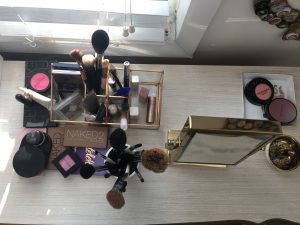
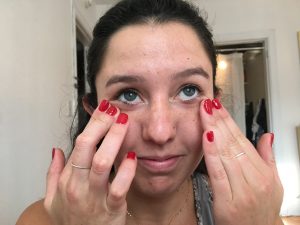
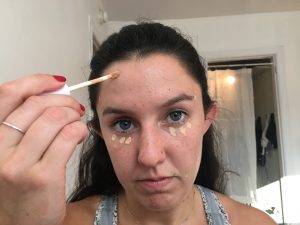
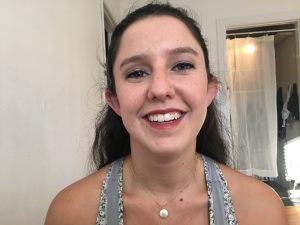
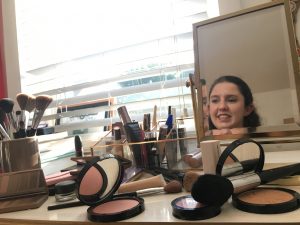
I noticed that Andrea and I both had similar ideas on an artistic process so I chose to post another 5 image story to add some more variety. The previous one is a year old. I liked seeing how she tackled the makeup idea differently.



